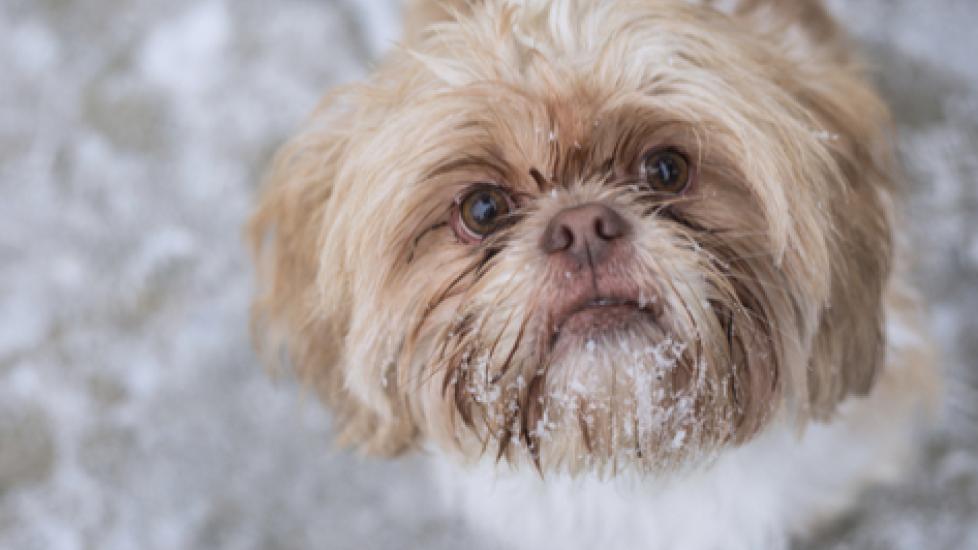How to Teach Your Dog to Go to the Bathroom in the Snow or Rain
By Diana Bocco
Does your dog "hold it" when the weather doesn't cooperate? Many dogs change their bathroom habits when it's snowing or raining particularly hard, or when it's a little too cold for their taste.
While this might not seem like a terrible thing at first, having a dog who refuses to step out of the house can lead to accidents inside—not to mention a very unhappy pup. "My own two dogs have snow issues," says Dr. Lori Pasternak, owner of Helping Hands Affordable Veterinary Surgery and Dental Care in Richmond, Virginia. "My Standard Poodle loves it but comes back inside with ice crystals and snow packed into his fur; my Chihuahua hates it and won't go near it."
If that sounds familiar, here are some tips to help your pup brave the bad weather.
Figure Out the Underlying Issue
Dogs refuse to go to the bathroom in bad weather for many reasons, including personality, size, age, and type of hair coat. Understanding which factor is affecting your dog will help you find a solution more easily. "For example, the terrain may not only look different, but smell and feel different," Pasternak says. "It may be slippery, scratchy, coarse, and especially freezing cold on the pads of their feet." Pasternak also points out that dogs who are trained to go only on grass may get confused when there is no grass to be seen.
Some dogs, especially those with tiny paws or thin coats, can be very sensitive to cold weather, says certified professional dog trainer Brandi Barker, owner of Barker Behavior in Chicago, Illnois, and Columbus, Ohio. "When the temperature drops, it becomes stressful for them to be outside, causing them to do what trainers refer to as 'shutdown,' meaning they can't move, they can't do anything, even urinate or defecate," Barker says.
Clear a Space
When dogs learn where to urinate and defecate, they create associations with their entire surroundings, including the sensation of grass, rocks, or mulch under their paws, according to Barker. "When those surfaces are wet, extremely cold, or imperceptible due to inches of snow, the landscape feels different, causing confusion," she says.
One way to help them is to make the ground feel as close as possible to what they're used to. "You may want to take the time to clear a small patch in the yard if possible, so your pet can see and feel the grass,” Pasternak says. Even better if you clear the area where he normally goes to the bathroom so it feels familiar.
Designate a Specific Bathroom Spot
One way to fight the refusal to go outside is to get your dog used to a specific bathroom spot when the weather is pleasant. If you keep taking him to the same place to go to the bathroom, he will eventually understand the connection. Then, when it's raining or snowing, you can take him to the same area to trigger that connection.
"Also, dogs like to mark where other animals have marked," Barker says. "If you don't have a backyard, take your dog to a familiar spot and one that other pups use to urinate and defecate."
Suit Them Up for the Weather
Get your dog used to all kinds of weather when he's still young. "Taking your pet out to play in the snow when it first starts snowing can be a fun way to introduce him to it before it sticks and covers the ground completely," Pasternak says. You can also try taking him for walks in the rain and make it a fun day out.
When it gets really cold, and especially if you have a short-haired dog, don't be afraid to put clothing on him. "If dogs tolerate a sweater or jacket, then I would encourage the use of them," Pasternak says. "If they have never worn one before, introducing clothing and snow at the same time may be sensory overload, though."
While some dogs won't appreciate booties, Pasternak recommends using them if your dog will tolerate them. Whatever you do, however, Pasternak says you shouldn't let your dog stay out for long periods of time on very cold days. "Hypothermia and frostbite can set in for dogs as quickly as for people," she says.
Make It a Positive Experience
If you manage to get your dog to go to the bathroom outside in bad weather, make a big deal about it. "Reward your dog with a high-value treat (not a treat he eats all the time) outside, when he does urinate and defecate," Barker says. "It's important to treat him while you're still outside and immediately after he does his business, so he makes the connection that poop or pee equals treats."
While you're waiting for that to happen, Barker suggests avoiding behavior that actually stresses out your dog and might make him hate the whole experience even more. Instead, Barker suggests taking a deep breath and avoiding impatient gestures when trying to get your dog to go to the bathroom outside. "It's tempting; no one likes standing in the freezing cold waiting for their pup to pee," Barker says. "However, leaning and getting frustrated adds tension, which is not helpful when a dog is struggling to understand what you want him to do."
